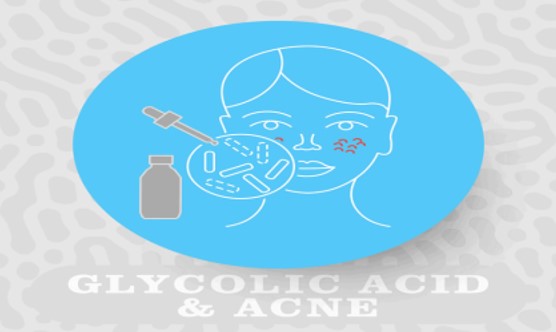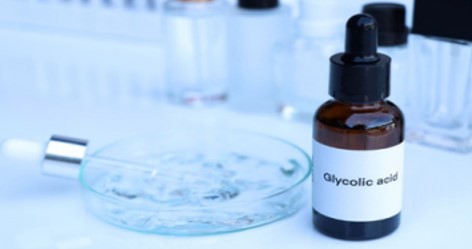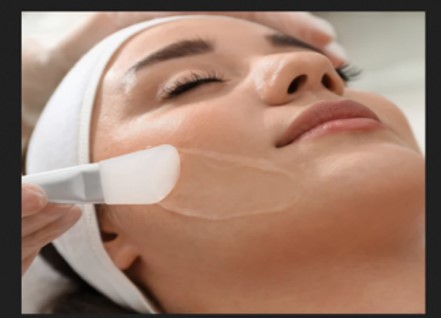Hyperpigmentation and Acne Treatment
Glycolic acid can lighten dark spots and acne scars by promoting the shedding of pigmented cells and encouraging the growth of new, evenly pigmented skin. It also helps control sebum production,reducing the likelihood of acne breakouts.
Chemistry Behind Glycolic Acid's Skin Benefits
Penetration and Exfoliation
Due to its small size, glycolic acid can easily penetrate the skin, breaking down the bonds between dead skin cells. This exfoliation process removes the outer layer of dead skin, which helps to unclog pores,reduce blackheads and whiteheads, and prevent new acne formation.
Cell Turnover and Collagen Production
By promoting cell turnover, glycolic acid encourages the growth of new skin cells. This not only helps in fading acne scars and hyperpigmentation but also improves overall skin texture. Moreover, glycolic acid stimulates collagen production, which can enhance skin elasticity and firmness, making the skin more resilient against future breakouts.
pH Balance and Antibacterial Properties
Glycolic acid lowers the skin’s pH, creating an environment that is inhospitable to acne-causing bacteria, such as Propionibacterium acnes. This antibacterial effect helps in reducing inflammation and preventing future acne eruptions.
Sebum Regulation
Glycolic acid can also help in regulating sebum production. By keeping the skin exfoliated and unclogged, it ensures that excess oil does not accumulate,thus reducing the likelihood of clogged pores and subsequent acne.
Enhanced Absorption of Skincare Products
Regular use of glycolic acid can enhance the skin’s ability to absorb other acne treatments and skincare products. By keeping the skin clear of dead cells, active ingredients in other treatments can penetrate more effectively, boosting their efficacy.
Here are the categories of products that commonly contain glycolic acid:
1. Cleansers:Used to cleanse and exfoliate the skin.
2. Toners:Applied after cleansing to further exfoliate and brighten the skin.
3. Serums:Concentrated treatments for targeted exfoliation and skin renewal.
4. Creams and Lotions:Moisturizers that include glycolic acid for ongoing exfoliation and hydration.
5. Masks and Peels:Intensive treatments for deep exfoliation and skin revitalization.
6. Body Care: Lotions and creams designed to exfoliate and smooth the skin on the body.
7. Prescription-Strength Products: High-concentration formulations prescribed by dermatologists for more severe skin issues.
Quick Tip: It's important to start with lower concentrations if you're new to glycolic acid and gradually increase as your skin builds tolerance. Consulting with a dermatologist can help determine the best products and regimen for your specific skin needs.
Dermatologists utilize glycolic acid in various treatments to help patients achieve healthier, clearer skin. Here’s how they incorporate this versatile ingredient into their practices:
Chemical Peels
Dermatologists often use glycolic acid in chemical peels to treat a range of skin concerns, including acne. During a glycolic acid peel, a high concentration of the acid is applied to the skin for a controlled period. This treatment exfoliates the outer layers of skin, unclogs pores, and promotes the shedding of dead skin cells. Chemical peels can help reduce the frequency and severity of acne breakouts, diminish the appearance of acne scars, and improve overall skin texture and tone.
Topical Treatments
Glycolic acid is a common ingredient in many over-the-counter and prescription topical treatments recommended by dermatologists. These include cleansers,toners, serums, and creams. Dermatologists prescribe or recommend products with appropriate concentrations of glycolic acid tailored to the patient’s skin type and specific needs. Regular use of these products can help maintain clear skin by preventing pore congestion,reducing inflammation, and promoting even skin tone.
Combination Therapies
Dermatologists often combine glycolic acid with other acne treatments to enhance overall efficacy. For instance,they might recommend using glycolic acid in conjunction with benzoyl peroxide, salicylic acid, or retinoids. This combination approach helps address multiple aspects of acne, such as bacteria, inflammation, and clogged pores, providing a more comprehensive treatment plan.
Customized Skincare Regimens
Dermatologists design customized skincare regimens that incorporate glycolic acid based on individual patient needs. They consider factors such as skin type,the severity of acne, and the patient’s lifestyle. By tailoring the use of glycolic acid, dermatologists ensure optimal results while minimizing potential side effects like irritation or dryness.
Professional Advice and Monitoring
Regular consultations with dermatologists allow for professional advice and monitoring. Dermatologists can adjust the concentration and frequency of glycolic acid treatments based on how the patient’s skin responds. This personalized approach ensures that the patient receives the maximum benefits of glycolic acid without compromising skin health.
Conclusion
Glycolic acid is a powerhouse ingredient in skincare, offering a wide range of benefits from exfoliation and anti-aging to hyperpigmentation and acne treatment. Its chemical diversity, biological significance, and ability to improve skin texture make it a valuable addition to any skincare routine. Whether derived from natural sources or synthesized in the lab, glycolic acid's multifaceted properties ensure it remains a cornerstone of effective skincare. However, glycolic acid's potency means it must be used correctly to avoid irritation. Different skin types may require different concentrations and application methods, making it crucial to consult with a skin specialist. To discover how glycolic acid can transform your skin and to get personalized advice on its use, contact your skin specialist today. They can guide you through its benefits and help you achieve the best possible results safely."
ABOUT THE AUTHOR -
She is a renowned MD Dermatologist with over 12 years of experience & has dedicated their career to understanding the complexities of skin health.
She diagnoses and treats dermatology conditions affecting the skin, hair, scalp, mouth, nails, and genitals.
She diagnoses and treats the patients at Fabderma Clinic, which is owned by herself and a leading medical and cosmetic dermatology clinic situated in Thane where a range of dermatology conditions are treated with the highest level of comfort.
When not in the clinic, she enjoys painting, shares valuable insights through YouTube channels and other social media platforms, online consultations - where she shares tips and advice on maintaining a healthy skincare routine.






